
THE TEA-TABLE: LAYING OUT TABLES, ETC.
Tea-tables in families—Paris fashion of evening parties— Breakfasts—Dejûners à la fourchette—Luncheons—Napkins, and how to fold them.
“Now stir the fire and close the shutters fast,
Let fall the curtains, wheel the sofa round;
And while the bubbling and loud hissing urn
Throws up a steamy column, and the cups,
That cheer, but not inebriate, wait on each,
So let us welcome peaceful evening in.”
THE tea-table is in most families a delightful relaxation. It is prepared with no trouble and little expense, and the only time, perhaps, a father can spare to have his family once a-day collected about him, where he may see the different dispositions of his children, and draw a knowledge of the general management of his family.
It is a great pity that the tea-table, as a magnet for social re-unions, is now, in our cities, so nearly obsolete. In Paris it has been partially introduced within the last few years;—but the pleasantest society there is in the evening, where they give nothing at all, where the ladies all work, and the gentlemen, if they do not play, walk about and converse with them.
An evening spent thus, in agreeable conversation, with well-informed and pleasant people, is a delightful relaxation to men engaged in engrossing pursuits during the day. If American ladies would add to this French fashion of evening re-unions the comfort of a cup of tea and a few cakes—without the fuss and formality attending fashionable evening parties—the pleasures of social intercourse with our friends would be immeasurably enhanced, and the extravagant expenses now incurred, entirely avoided.
Breakfasts, Luncheons, and Folding Napkins.—The art of laying out a table, whether for breakfast, luncheon, dinner, tea, or supper, consists in arranging the various dishes, plate, glass, &c, methodically, and adhering to the rules we are about to make known.
Much trouble, irregularity, and confusion will be avoided in a house where there is company, if servants are instructed to prepare the table, sideboard, or dinner-wagon, in a similar manner or order daily.
All tables are usually laid out according to the following rules:—

Breakfasts.—The table should be covered with a clean white cloth; the cups and saucers arranged at one end, if for tea; and at both ends, if for tea and coffee; or the coffee-cups and saucers may be arranged at the right-hand side of one end of the table, and the tea-cups and saucers at the left: the teapot and coffee-pot occupying the space between in front, and the urn that at the back. Some persons substitute cocoa or chocolate for coffee, in which case they are to be placed the same. The slop basin and milk jug should be placed to the left; and the cream, and hot milk jugs, with the sugar basin, to the right.
The remainder of the table should be occupied in the centre by the various dishes to be partaken of; while at the sides must be ranged a large plate for meat, eggs, &c., and a small one for toast, rolls, &c., with a small knife and fork for each person; the carving-knife and fork being placed point to handle; the butter and bread knives to the right of their respective dishes, which occupy the centre part, and spoons in front of the hot dishes with gravy. Saltcellars should occupy the four corners, and, if required, the cruets should be placed in the centre of the table.
Dry toast should never be prepared longer than five minutes before serving, as it becomes tough, and the buttered soppy and greasy, if too long prepared. Hot rolls should be brought to table covered with a napkin.
Every dish should be garnished appropriately, either with ornamental butter, water-cresses, parsley, or some one of the garnishes we shall point out in a future page.
The dishes usually set upon the table are selected from hot, cold, and cured meats; hot, cold, cured, and potted fish; game, poultry, cold or devilled; fruit, ripe, preserved, or candied; dressed and undressed vegetables; meat pies and patties, cold; eggs; honeycomb; entrées; and savory morsels—as grilled kidneys, ham toast, devils, &c.

Dèjûners à la fourchette are laid the same as suppers, except that tea and coffee are introduced; but not until the solids are removed.
When laid for a marriage or christening breakfast, a bride’s or christening cake should occupy the centre instead of the épergne or plateau.

Luncheons, or Noonings.—The luncheon is laid in two ways. One way is to bring in a butler’s tray with let-down sides, on which it is previously arranged upon a tray cloth, and, letting down the sides and speading the cloth upon the dining-table, to distribute the things as required. The other is to lay the cloth as for dinner, with the pickle-stand and cruets opposite each other; and, if in season, a small vase of flowers in the centre; if not, a water-jug and tumblers, which may be placed on a side-table at other times. The sides of the table are occupied by the requisites for each guest, viz., two plates, a large and small fork and knifes, and dessertspoon. A folded napkin, and the bread under, is placed upon the plate of each guest.
Carafes, with the tumblers belonging to and placed over them, are laid at the four corners, with the saltcellars in front of them, between two tablespoons laid bowl to handle.
The dishes generally served for luncheons are the remains of cold meat neatly trimmed and garnished; cold game, hashed or plain; hashes of all descriptions; curries; minced meats; cold pies, savory, fruit, or plain; plainly cooked cutlets, steaks, and chops; omelettes; bacon; eggs; devils and grilled bones; potatoes; sweetmeats; butter; cheese; salad and pickles. In fact, almost any thing does for lunch, whether of fish, flesh, fowl, pastry, vegetables, or fruit.
Ale and porter are generally served, but occasionally sherry, marsalla, port, or home-made wines are introduced, with biscuits and ripe fruit.
A good housewife should always have something in the house ready to convert into a neat little luncheon, in case a few friends drop in, to what some are pleased to call a “tiffin;” and it is astonishing how a really handsome-looking affair may be made out of the remains of the dinner served the day before, some handsome glass, a sprinkle of good plate, a few flowers, and above all, a hearty welcome.

Napkins.—Dinner napkins should be about twenty-eight inches broad, and thirty inches long. They may be folded in a variety of ways, which impart a style to a table, without adding much to the expense, and may be readily accomplished with a little practice and attention to the following directions and diagrams:—

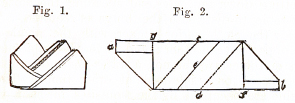
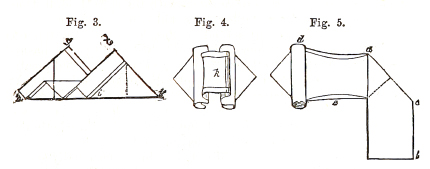
The Mitre. (Fig. 1.)—Fold the napkin into three parts lengthwise, then turn down the right-hand corner, and turn up the left-hand one, as in Fig. 2, a and b. Turn back the point a toward the right, so that it shall lie behind c; and b to the left, so as to be behind d. Double the napkin back at the line e, then turn up f from before, and g from behind, when they will appear as in Fig. 3. Bend the corner h toward the right, and tuck it behind i, and turn back the corner k toward the left, at the dotted line, and tuck it into a corresponding part at the back. The bread is placed under the mitre, or in the centre at the top.
The Exquisite. (Fig. 4.)—Fold the napkin into three parts lengthwise, then fold down two fifths of the length from each side, as in Fig. 5, at a; roll up the part b toward the back, repeat on the other side, then turn up the corner toward the corner a, and it will appear as d. The centre part e is now to be turned up at the bottom, and down at the top, and the two rolls brought under the centre piece as in Fig. 4. The bread is placed under the centre band, k, Fig. 4.

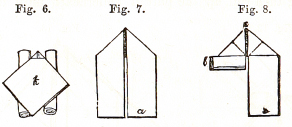
The Collegian. (Fig. 6.)—Fold the napkin into three parts lengthwise, then turn down the two sides toward you, so that they shall appear as in Fig. 7; then roll up the part a underneath, until it looks like b, Fig. 8. Now take the corner b and turn it up toward c, so that the edge of the rolled part shall be even with the central line; repeat the same on the other side, and turn the whole over, when it will appear as in Fig. 6. The bread is placed underneath the part k.

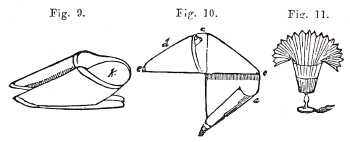
The Cinderella, (Fig. 9.)—Fold the napkin into three parts lengthwise, then turn down the two sides as in Fig. 7; turn the napkin over, and roll up the lower part as in Fig. 10, a, b. Now turn the corner b upwards toward c, so that it shall appear as in d; repeat on the other side, and then bring the two parts e together, so that they shall bend at the dotted line; and the appearance will now be as Fig. 9. The bread is placed under the apron part k, Fig. 9.

The Flirt. (Fig. 11.)—Fold the napkin into three parts lengthwise; then fold across the breadth, commencing at one extremity, and continuing to fold from and to yourself in folds about two inches broad, until the whole is done; then place in a tumbler, and it will appear as in the illustration.

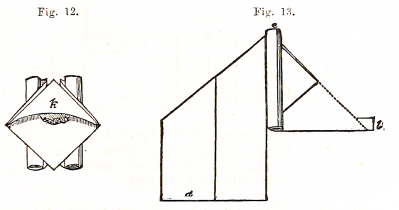
The Neapolitan. (Fig. 12.)—Fold the napkin into three parts lengthwise, then fold one of the upper parts upon itself from you; turn over the cloth with the part having four folds from you, then fold down the two sides so as to appear as in Fig. 7; then roll up the part a underneath until it appears as in the dotted lines in Fig. 15, at b. Now turn up the corner b toward c, so that the edge of the rolled part shall be even with the central line: repeat the same upon the opposite side, and turn the whole over, when it will appear as in Fig. 14: the bread being placed underneath the part k, as represented in the illustration.

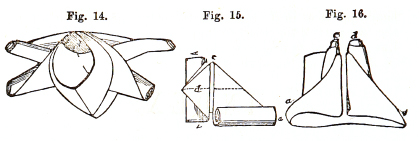
The Favorite, or Our Own (Fig 14.)—Fold the napkin into three parts lengthwise, then turn down the two sides as in Fig. 7, and roll up the part a on both sides, until as represented on the right-hand side in Fig. 14; then turn it backwards (as a b) on both sides; now fold down the point c toward you, turn over the napkin, and fold the two other parts from you so that they shall appear as in Fig. 15. Turn the napkin over, thus folded, and raising the centre part with the two thumbs, draw the two ends (a and b) together, and pall out the parts (c and d) until they appear as in Fig. 13. The bread is to be placed as represented in k, Fig. 13.

RULES FOR CHILDREN.
“ In silence I must take my seat
And give God thanks before I eat;
Must for my food in patience wait,
Till I am asked to hand my plate;
I must not scold, nor whine, nor pout,
Nor move my chair nor plate about,
With knife, or fork, or napkin ring,
I must not play; nor must I sing;
I must not speak a useless word,
For children should be seen—not heard;
I must not talk about my food.
Nor fret if I don’t think it good;
I must not say, ‘The bread is old,’
‘The tea is hot,’ ‘The coffee’s cold.’
I must not cry for this or that,
Nor murmur if my meat is fat.
My mouth with food I must not crowd,
Nor while I’m eating, speak aloud;
Must turn my head to cough or sneeze,
And when I ask, say, ‘If you please;’
The table-cloth I must not spoil,
Nor with my food my fingers soil;
Must keep my seat when I have done,
Nor round the table sport nor run;
When told to rise, then I must put
My chair away with noiseless foot;
And lift my heart to God above,
In praise for all his wondrous love.”